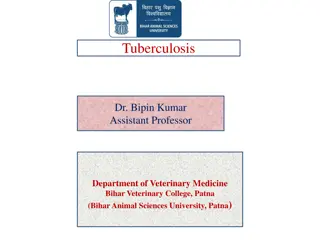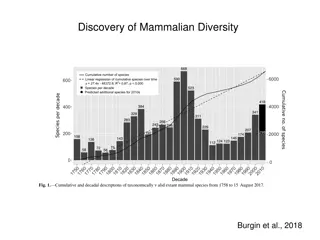Explore the Fascinating World of Wild Animals and Their Habitats!
Journey through a visual encyclopedia showcasing a variety of wild animals such as bears, cheetahs, elephants, and more, along with information on different animal types like mammals, reptiles, and birds. Discover the diverse habitats where these creatures reside, from jungles and forests to deserts
0 views • 35 slides
Revolutionizing Marine Mammal Detection using Geospatial Artificial Intelligence
Delve into the groundbreaking development of an operational system utilizing geospatial artificial intelligence to detect marine mammals in very high-resolution satellite imagery. Explore the global interest, monitoring platforms, proof of concept, limitations, future possibilities, and innovative a
0 views • 20 slides
Understanding Animal Classification: Mammals, Birds, Reptiles, Fish, and Amphibians
Explore the world of animal classification through 5 distinct groups - mammals, birds, reptiles, fish, and amphibians. Discover what sets each group apart, from their bone structure to unique characteristics like fur, beaks, scales, and more. Engage in activities to identify and understand the featu
10 views • 4 slides
Mammalian Dentition and Tooth Structure Exploration
Understanding dentition in mammals sheds light on their evolution, classification, age approximation, and dietary habits. The arrangement of teeth, tooth structure, development, and types of mammalian teeth are discussed, highlighting unique features like thecodont attachment, enamel coating, and de
2 views • 16 slides
Comparing Groups of Vertebrates: Features and Differences
Explore the key characteristics of five groups of vertebrates - mammals, birds, reptiles, amphibians, and fish - including details on blood type, offspring, skin, and breathing apparatus. Learn about the unique traits that distinguish these vertebrate groups from one another.
0 views • 4 slides
Explore the World of Cetaceans with Cetacean BINGO Call List
Delve into the fascinating world of cetaceans with the Cetacean BINGO Call List. Learn interesting facts about different whale species such as the Gray whale, Right whale, Minke whale, Humpback whale, Porpoise, Fin whale, Blue whale, Beluga, Dolphin, Bowhead whale, Narwhal, Pilot whale, Sperm whale,
0 views • 16 slides
Bovine Tuberculosis: A Zoonotic Disease Impacting Humans and Animals
Bovine tuberculosis is a chronic bacterial disease affecting cattle and other mammals, with potential transmission to humans. Endemic in developing countries, it poses public health risks. Modes of transmission, clinical symptoms, diagnosis, and control measures are discussed, highlighting the impor
0 views • 22 slides
Adaptations of Flying Mammals and Fish for Aerial Life
Explore the fascinating adaptations of flying mammals like Pteropus, commonly known as flying foxes, and flying fish like Exocoetus for their arboreal and aerial lifestyles. From modified wings to unique habitats, discover how these creatures have evolved for flight and survival in their environment
2 views • 16 slides
Understanding Reproduction in Animals: Viviparous and Oviparous Examples
Explore the concepts of viviparous and oviparous animals with examples like mammals and birds. Witness the life cycles of various animals, from birth to adulthood, including metamorphosis in insects. Discover how human body changes as we grow.
0 views • 11 slides
Understanding Homeostasis in Humans and Mammals
Humans and mammals rely on homeostasis to maintain a constant internal environment for survival. This involves regulating core body temperature, blood glucose levels, and water levels through nervous and hormonal responses. By understanding the principles of homeostasis, we can appreciate the vital
0 views • 22 slides
Fascinating Facts About Echidnas - Quirks of Egg-Laying Mammals
Echidnas, intriguing egg-laying mammals, have unique traits like quill-covered bodies, backward-facing feet, and a long tongue for catching ants and termites. They are solitary except during breeding season and are known for their low body temperature. Learn more about these fascinating creatures!
0 views • 4 slides
Understanding Aquatic Adaptation in Animals
Aquatic adaptation refers to the changes in an animal's body organization to thrive in a water habitat. Vertebrates have evolved to lead partial or total aquatic lives, showcasing various adaptations. Water as a habitat offers a homogenous medium, stable conditions, and rich food resources. Aquatic
0 views • 9 slides
Dugong Conservation Efforts in Palau
Palau, home to the isolated dugong population in Micronesia, faces challenges in protecting these vulnerable marine mammals. Despite international and local regulations, dugongs in Palau are still threatened by habitat degradation, hunting, and declining populations. Conservation efforts are crucial
0 views • 16 slides
Life Cycle and Morphology of Blood and Tissue Flagellates in Parasitology
Blood and tissue flagellates, such as Leishmania and Trypanosoma, have complex life cycles involving vertebrate and arthropod hosts. They go through various stages with distinct morphological features like promastigote, epimastigote, trypomastigote, and amastigote. Leishmania mainly infects mammals
0 views • 16 slides
Understanding Mycobacterium: Causes and Impact of Tuberculosis
Mycobacterium is a genus of Actinobacteria known for causing serious diseases in mammals, including tuberculosis (TB) and leprosy. Tuberculosis, caused mainly by Mycobacterium tuberculosis, is a chronic infection that affects the lungs and various organs, especially prominent in developing regions d
0 views • 25 slides
A Comparative Analysis of Ectothermy vs. Endothermy in Organisms
Ectotherms regulate body temperature externally, relying on environmental heat sources, while endotherms produce heat internally. Ectotherms like reptiles and fish have advantages such as lower metabolic rates and food requirements, while endotherms like birds and mammals have higher energy needs du
0 views • 16 slides
Insights into Hibernation in Animals: Functions and Varieties
Hibernation is a fascinating biological phenomenon observed in various animals, enabling them to survive harsh conditions by conserving energy. This state of inactivity and metabolic depression is crucial for species like bears, pygmy possums, and bats during winter months. Animals hibernate to cope
0 views • 15 slides
Exploring Dairy Products and Milk Varieties
The article delves into the realm of dairy products, focusing on various types such as milk, cheese, yogurt, cream, and butter. It explains how milk, produced by mammals like cows and sheep, serves as a vital source of nutrition for infants. Additionally, it details different heat treatments applied
3 views • 75 slides
Learn About Animals Through This Interactive PowerPoint Presentation
Explore the fascinating world of animals in this interactive PowerPoint presentation. Discover the six groups of animals categorized in unique classes with fun facts and engaging visuals. You'll get to learn about mammals, birds, and more while filling in blanks and pasting pictures of different ani
0 views • 29 slides
Understanding Social Hierarchies in Animal Behavior
Social behavior in animals involves living in social groups, establishing social hierarchies, and exhibiting dominance behaviors. Animals have developed various signals and behaviors to interact successfully within these groups. Social hierarchies offer advantages such as increased chances of surviv
1 views • 20 slides
Fascinating Facts About Bats Around the World
Bats are incredible mammals found in various habitats worldwide, with over 1,300 species known. They play vital roles such as pollination, pest control, and seed dispersal. From the tiny bumblebee bat to the giant flying foxes, bats showcase diverse adaptations and behaviors like echolocation and un
0 views • 19 slides
Fascinating Facts About Marine Mammals
Explore the unique characteristics of marine mammals like manatees, dugongs, walruses, sea lions, elephant seals, leopard seals, and sea otters. Learn about their distinctive features, sizes, behavior, and habitats. Discover the diverse suborders of pinnipeds and the intriguing world of these fascin
1 views • 17 slides
Adaptations in Marine Mammals - Insights into Their Unique Survival Strategies
Delve into the world of marine mammals and explore their fascinating adaptations for life in the ocean. From using echolocation to finding food to having blubber for insulation, these creatures have evolved various survival strategies to thrive in their aquatic habitats.
0 views • 13 slides
Adaptations and Characteristics of Mammals in Terrestrial Environments
Mammals are well adapted to various terrestrial conditions, inhabiting water, air, and soil. They maintain a stable body temperature, have fur for temperature regulation and protection, and unique limbs for different modes of movement. The distinguishing features of mammals include fur, specialized
0 views • 39 slides
Power of Regeneration in Nature and Beyond
Explore the fascinating world of regeneration as seen in different organisms such as sea sponges, plants like rose bushes, earthworms, starfish, salamanders, and even mammals like rabbits and humans. Discover the remarkable ability of these creatures to regenerate and recover from injuries, highligh
0 views • 15 slides
Vertebrates Final Review - Study Guide with Images
Explore the world of vertebrates with this comprehensive final review. Learn about chordates, fish, amphibians, reptiles, birds, and mammals through informative images and questions. Test your knowledge on topics like excretion, respiratory organs, locomotion, and anatomical features unique to chord
0 views • 74 slides
Contaminant Levels in Alaskan Populations and Marine Mammals
The content discusses the presence of contaminants in Alaskan populations and marine mammals, highlighting factors influencing contaminant levels, variations based on species, tissues, age, and sex, as well as potential risks associated with elevated body burdens. It emphasizes the importance of con
0 views • 25 slides
Fascinating Facts About Dolphins
Dolphins consume a variety of prey including fish, squid, and crustaceans. They are able to breathe both water and air, showcasing their incredible adaptability. With a preference for cold climates and a natural shelter in the form of gulfs, dolphins are fascinating marine mammals that captivate and
0 views • 5 slides
Exploring What Makes Whales Unique in the Marine Mammal World
Delve into the fascinating world of whales, understanding the key characteristics that distinguish them as mammals of the sea. From warm-blooded creatures with backbones to air-breathing giants, witness how whales give birth to live young, nurse their offspring, and truly embody the essence of marin
0 views • 25 slides
Learning About Dogs: Vocabulary and Characteristics
Explore essential vocabulary related to dogs, including terms like "hairy," "mammals," "litter," and more. Learn about the characteristics of dogs, their coats, behaviors, and care routines through engaging descriptions and images in this educational content.
1 views • 9 slides
Fascinating Discoveries in Mammalian Diversity
Recent scientific findings have unveiled new species of mammals like the gymure Podogymnura intermedia in the Philippines and chipmunks Tamias cratericus and T. grisescens. Notably, the discovery of Rice's whale highlights the critical condition of this species. The evolution and varied characterist
0 views • 28 slides
Fascinating Facts About Foxes
Foxes are omnivorous mammals from the Canidae family, commonly known as wild dogs. They come in 12 different species, with unique features like bushy tails and pointed ears. Male foxes are called reynards, females vixens, and babies pups or cubs. These animals have a diverse diet and can be found in
1 views • 8 slides
Environmental Risk Assessment of Australian Marsupials and Native Rodents
Explore the challenges and solutions in conducting environmental risk assessments for terrestrial vertebrates like marsupials, native rodents, and birds in Australia. Dive into topics such as exposure calculations, toxicity evaluations, and data gaps that influence decision-making processes. Gain in
0 views • 45 slides
Understanding Mammalia Classification and Characteristics
Mammalia, a class of animals, exhibit distinct characteristics like hair presence, mammary glands for young ones, and warm-bloodedness. They are classified into subclasses like Prototheria (egg-laying), Metatheria (marsupials), and Eutheria (placental mammals). Monotremes belong to Prototheria and i
0 views • 27 slides
Understanding Induction of Parturition in Mammals
Induction of parturition in mammals involves the essential roles of progesterone, luteal regression, fetal cortisol, and the shift from progesterone to estrogen. This process is crucial for saving the lives of both the dam and fetus. Corticosteroids like dexamethasone and flumethasone are commonly u
0 views • 10 slides
Understanding Color Vision in Primates and Mammals
Explore the fascinating world of color vision in primates and other mammals through trichromatic and dichromatic color vision systems. Discover how dichromats and trichromats perceive colors differently due to the types of color-detecting cells in their retinas. Learn why most mammals are dichromats
0 views • 24 slides
Exploring the World of Mammals
Delve into the diverse world of mammals, characterized by unique features like specialized teeth, hair, and mammary glands. Learn about the different groups of mammals, from primitive monotremes to specialized placental mammals. Witness the fascinating adaptations of marsupials, placentals, and vari
0 views • 20 slides
Mammalian Dentition and Tooth Structure
Dentition refers to the arrangement of teeth in the upper and lower jaw of mammals. Most mammals have specialized teeth, with some exceptions like the Platypus and Baleen whales. The structure of a mammalian tooth includes the crown, root, and neck, made up of dentine, enamel, and cement. Tooth deve
0 views • 13 slides
Exploring Vertebrates: Reptiles, Birds, and Mammals
Delve into the world of vertebrates, including reptiles, birds, and mammals. Discover the unique characteristics and adaptations of each group, from the scales of reptiles to the feathers of birds and the live birth of mammals. Explore how these creatures have evolved to thrive in their environments
0 views • 6 slides
Impacts of Global Population Dynamics and Climate Change on Large Mammals
This study by Mark Hebblewhite and colleagues compares the species-level impacts of global population dynamics and climate change on two contrasting large mammals. The research, led by Hebblewhite, Post, and Ahrestani, emphasizes the importance of understanding how these factors affect the survival
0 views • 37 slides







































